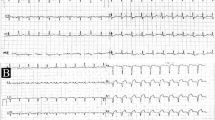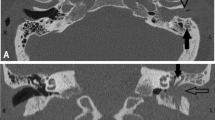Abstract
A rare case of a patient with unusual symptoms of earache and sore throat for cardiac ischemia is presented. A diagnosis of non-ST-segment elevation myocardial infarction (NSTEMI) was made based on initial elevation of troponin and an abnormal electrocardiograph (ECG). Percutaneous coronary intervention (PCI) performed with stent placement in the occluded coronary vessel was followed by a decrease in troponin level and complete resolution of the ear and throat pain and patient recovery from cardiac ischemia.
Similar content being viewed by others
Introduction
Chest pain is a typical symptom of acute coronary syndrome (ACS), of which there are three common types: unstable angina (UA), ST segment elevation (STEMI) of myocardial infarction (MI), and non-ST-segment elevation of MI (NSTEMI) [1, 2]. The underlying pathology is atherothrombosis. Symptoms of ACS in the absence of chest pain are dyspnea, nausea, sweating, neck or jaw and arm pain. Ear pain and sore throat are rare symptoms of ACS [3], which makes diagnosis and treatment difficult and challenging. Misdiagnosis in such cases could lead to delayed treatment and increased mortality. We present a rare case of a patient presented to the emergency department of our hospital with symptoms of earache and sore throat for cardiac ischemia.
Case report
A 53-year-old African-American female presented to the ED complaining of earache and sore throat for 3 days. She described the pain as a burning sensation that was worst when she woke up in the morning and got better as the day progressed. The patient denied chest pain, shortness of breath, nausea, vomiting, or dizziness. Her only complaint was being tired, and her right ear was throbbing. She asked to be screened for H1N1 and requested a course of antibiotics.
The patient worked as a telemarketer, described her job as very stressful, and claimed to smoke one to two cigarettes per week. Her medical history was significant for dyslipidemia, newly diagnosed type 2 diabetes, and chest discomfort diagnosed 4 months ago at a different hospital as STEMI with complete occlusion of the RCA. There were no complaints of earache recorded at that time. She was treated at the hospital by placement of a bare-metal stent in her RCA. Current home medications included clopidogrel, aspirin, statin, beta-blocker, metformin, and nitroglycerin sublingually as needed for chest pain. Her vital signs on arrival at the ED were: Bp of 131/82 mmHg, pulse of 70 beats per minute, respiratory rate of 17 breaths per minute, temperature of 98° F, and oxygen saturation of 98% on room air. Because of multiple risk factors, in addition to a symptom that could potentially be a referred cardiac pathology, an ECG, chest radiograph, and cardiac biomarkers were ordered at the triage. Cardiovascular, pulmonary, abdominal, ear, nose, and throat examinations were unremarkable. The initial ECG displayed no ST segment elevation, but T wave inversion in inferior leads that was unchanged from a previous ECG. Blood tests showed elevated cardiac enzyme (troponin 0.76 ng/ml). A presumptive diagnosis of ACS/ NSTEMI was made on the basis of an elevated troponin combined with the ECG changes. After the ACS protocol was initiated, a cardiology consultation was requested, and the patient was admitted to our hospital.
On admission, the patient continued to complain of throbbing ear pain that fluctuated now between the two ears, but again denied chest pain or shortness of breath.
On the 2nd day her troponin had increased to 1.24 ng/ml. Restenosis was suspected, and cardiac catheterization was performed. It was found that the previous bare-metal stent in the posterolateral branch (distal RCA) was completely occluded, and no balloon could be advanced beyond that area. A new lesion in the proximal/ostial RCA greater than 70% occlusion was opened with a successful placement of a PCI at the ostial RCA using a drug-eluting stent. Following this, her ear and throat pains were completely resolved. Her troponin level had declined to 0.63 ng/m on the 3rd day, and the patient was discharged with a referral for cardiac rehabilitation. We concluded on follow-up that otalgia in this patient was an atypical symptom of referred angina pain.
The patient was seen 2 weeks later at the cardiology clinic of our hospital and reported no complaints about her condition or recurrence of ear pain. An ECG revealed no changes from the previous one done 2 weeks earlier at the time of discharge.
Discussion
The underlying pathophysiology of the referred otalgia in this patient can be explained by the autonomic dysfunction of the auricular branch of the vagus nerve often termed Alderman’s nerve. This branch of the vagus innervates the inner portion of the outer ear, and also controls the skeletal muscles including the superior, middle and inferior pharyngeal constrictors. The sinoatrial (SA) node is innervated by the right vagus, which receives blood supply from the RCA. We suggest that partial occlusion of the RCA promoted damage of the parasympathetic fibers of the right vagus, and was the cause of referred otalgia and pharyngitis in our patient. Sensory nerves are affected by type 2 diabetes [4–7], but whether such a preexisting condition predisposes a person to angina-referred otalgia or pharyngitis is not clear.
To our knowledge, symptoms of ear pain for CAD and acute arterial occlusion in a patient have rarely been discussed in the literature. We found only one report [8]; in this report the correct diagnosis of cardiac ischemia was missed in two patients who were initially treated for primary ear pain. In conclusion, clinicians should be aware and recognize that ear and throat pain may represent symptoms for cardiac ischemia.
References
Ambrose JA, Dango G (2000) Unstable angina: current concepts of pathogenesis and treatment. Arch Intern Med 160:25–37
Cunningham MC, Reilly JP, Lavie CJ, Sundell ET (2008) Unstable angina and NSTEMI: are you up to date? Emerg Med 40:20–26
Canto JG, Shlipak MG, Rogers WJ, Malmgren JA, Frederick PD, Lambrew CT, Ornato JP, Barron HV, Kiefe CI (2000) Prevalence, clinical characteristics, and mortality among patients with myocardial infarction presenting without chest pain. JAMA 283:3223–3229
Trichon BH, Matthew TR (2004) Diabetes and vascular disease research: acute coronary syndromes and diabetes mellitus. Diab Vasc Dis Res 1:24–32
Hammoud T, Tanguay JF, Bourassa MG (2000) Management of coronary artery disease: thereupetic options in patients with diabetes. J Am Coll Cardiol 36:355–65
Berry C, Tardiff JC, Bourassa MG (2007) Coronary heart disease in patients with diabetes. J Am Coll Cardiol 49:643–656
Wittsley CD (2002) Atypical myocardial infarction in a man with type 2 diabetes. Clin Diabetes 20:101–102
Rothwell PM (1993) Angina and myocardial infarction presenting with pain confined to the ear. Postgrad Med J 69:300–301
Acknowledgement
We thank Raza Latif Khan, MD, and Deborah Williams, MD, for helpful discussions and critical reading of the manuscript.
Conflicts of interest
None.
Author information
Authors and Affiliations
Corresponding author
Rights and permissions
Open Access This article is distributed under the terms of the Creative Commons Attribution 2.0 International License (https://creativecommons.org/licenses/by/2.0), which permits unrestricted use, distribution, and reproduction in any medium, provided the original work is properly cited.
About this article
Cite this article
Amirhaeri, S., Spencer, D. Myocardial infarction with unusual presentation of otalgia: a case report. Int J Emerg Med 3, 459–460 (2010). https://doi.org/10.1007/s12245-010-0222-8
Received:
Accepted:
Published:
Issue Date:
DOI: https://doi.org/10.1007/s12245-010-0222-8




